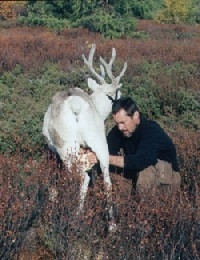The Fairies are said to be as fond of deer’s milk as of venison. On a hill called Beinn Bhreac there was frequently seen a noted Fairy milking the deer. She was one day observed by two hunters going round the deer, and after gathering them into a gorge in the side of the hill she commenced milking them one by one, singing a kind of lullaby the while, till she came to one which was so restive as not to suffer her to come near but ran off up the hill, she following with almost equal speed. Seeing that she was loosing ground, she suddenly stopped and exclaimed :-
‘Saighead Fhionnlaidh ort a bhradaig Ge b’ oil le d’ ladhranb heiri stad ort Luaidhe Mhic Iain Chaoil ‘na d’ chraicionn ‘S buarach na Baoibhe mu t’ adharcan.’
‘Finlay’s arrow in thee, thou thief, In spite of thy hoofs it will make thee stop; Mac Iain Chaoil’s lead in thy carcass And the Fairy’s Buarach on thy horns (legs).’
Finlay was the chief of the Fairies, as is evident from their being called ‘Sluagh Fhionnlaidh,’ or Finlay’s People. My informant could not tell who ‘Mac Iain Chaoil’ was. The English of the name is Son of Slender John. The Fairy herself was the Fury. Buarach is a kind of shackle made of hair or hemp used to tie round the hind legs of cows to keep them from kicking while they are being milked. It is universally used in the Outer Hebrides to the present day. No sooner had the Bean-shith or Fairy woman pro-nounced these words than the deer stopped and suffered herself to be milked. The Pibroch of Cronan Cailleach na Beinne Bric is said to have been composed upon this Fairy, the air being in imitation of the tones and modulations of her voice in her lullaby when milking the deer. Anon ‘Fairy Tales’, The Celtic Review 5 (1908), 155-171 at 157-158


